Chapter: 11th Chemistry : UNIT 5 : Alkali and Alkaline Earth Metals
General characteristics of alkaline earth metals
General
characteristics of alkaline earth metals
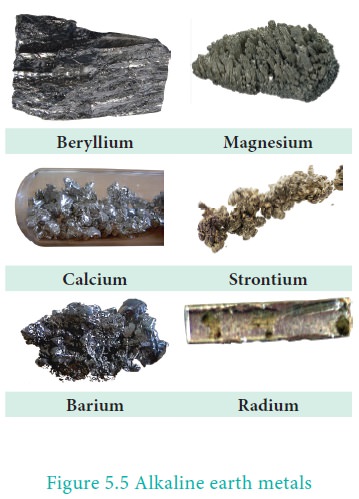
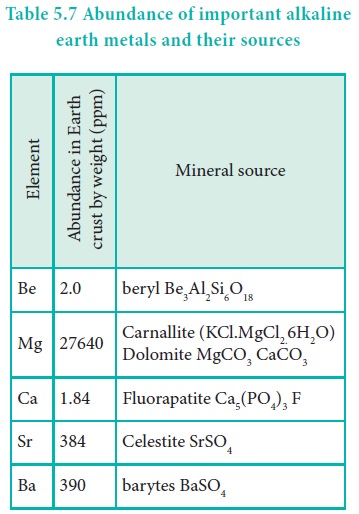
Physical state
Beryllium is rare and radium is the rarest of all
comprising only 10 % of igneous rocks. Magnesium and calcium are very common in
the earth’s crust, with calcium the fifth-most-abundant element, and magnesium
the eighth. Magnesium and calcium are found in many rocks and minerals:
magnesium in carnallite, magnesite, dolomite and calcium in chalk, limestone,
gypsum. Most strontium is found in the minerals celestite and strontianite.
Barium is slightly less common, much of it in the mineral barite. Radium, being
a decay product of uranium, is found in all uranium-bearing ores.
Electronic configuration
These elements have two electrons in the valence shell of
their atoms, preceded by the noble gas configuration. Their general electronic
configuration is written as [Noble gas]ns2 where ‘n’ represents the
valence shell.

Atomic and ionic radii
The atomic and ionic radii of alkaline earth metals are
smaller than the corresponding members of the alkali metals. This is due to the
fact the Group 2 elements having a higher nuclear charge that allows electrons
to be attracted more strongly towards the nucleus. On moving down the group,
the radii increases due to gradual increase in the number of the shells and the
screening effect.
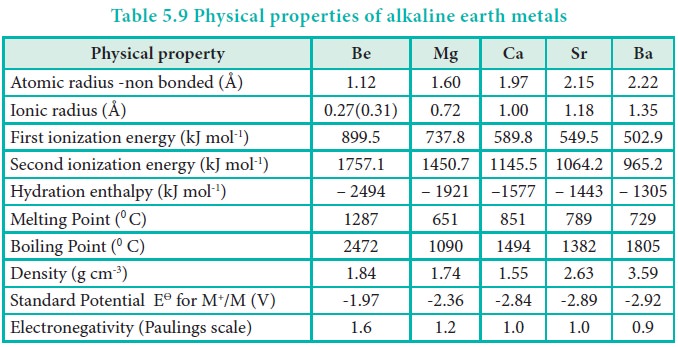
Common oxidation state
The group 2 elements have two electrons in their valence
shell and by losing these electrons, they acquire the stable noble gas
configuration. So these elements exhibit +2 oxidation state in their compounds.
Ionisation enthalpy
Due to a fairly large size of the atoms, alkaline earth
metals have low ionisation enthalpies when compared to ‘p’ block elements. Down
the group the ionisation enthalpy decreases as atomic size increases. This is
due to the addition of new shells as well as increase in the magnitude of the
screening effect of inner shell electrons. Members of group 2 have higher
ionization enthalpy values than group 1 because of their smaller size, with
electrons being more attracted towards the nucleus of the atoms.
Correspondingly they are less electropositive than alkali metals.
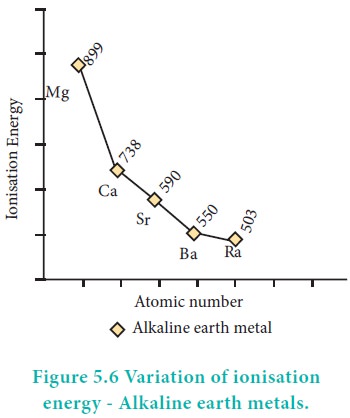
Although IE1 values of alkaline earth metals
are higher than that of alkali metals, the IE2 values of alkaline
earth metals are much smaller than those of alkali metals. This occurs because
in alkali metals the second electron is to be removed from a cation, which has
already acquired a noble gas configuration. In the case of alkaline earth
metals, the second electron is to be removed from a monovalent cation, which
still has one electron in the outermost shell. Thus, the second electron can be
removed more easily in the case of group 2 elements than in group 1 elements.
Hydration Enthalpies
Compounds of alkaline earth metals are more extensively
hydrated than those of alkali metals, because the hydration enthalpies of
alkaline earth metal ions are larger than those of alkali metal ions.
Like alkali metal ions, the hydration enthalpies of
alkaline earth metal ions also decrease with increase in ionic size down the
group.
Be > Mg > Ca > Sr > Ba
e.g., MgCl2 and CaCl2 exist as MgCl2.6H2O
and CaCl2· 6H2O while NaCl and KCl do not form such
hydrates.
Electronegativity
In alkaline earth metals the electronegativity values
decrease as we go down the group as seen in the alkali metals.
Flame colour and the spectra:
When the alkaline earth metal salts moistened with
concentrated hydrochloric acid are heated on a platinum wire in a flame, they
show characteristic coloured flame as shown below.
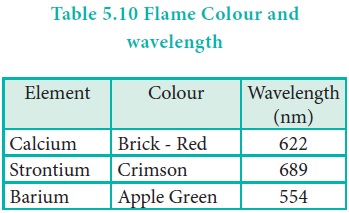
The heat in the flame excites the valence electron to a
higher energy level. when it drops back to its actual energy level, the excess
energy is emitted as light, whose wavelength is in the visible region as shown
in the above table.
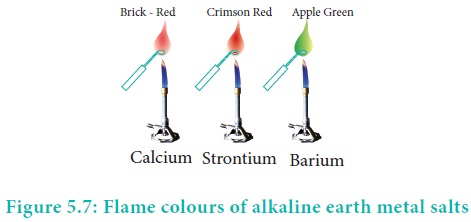
Related Topics